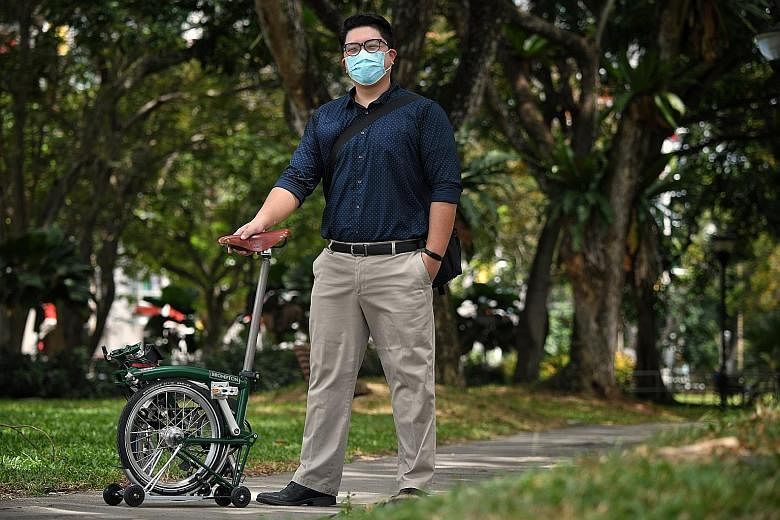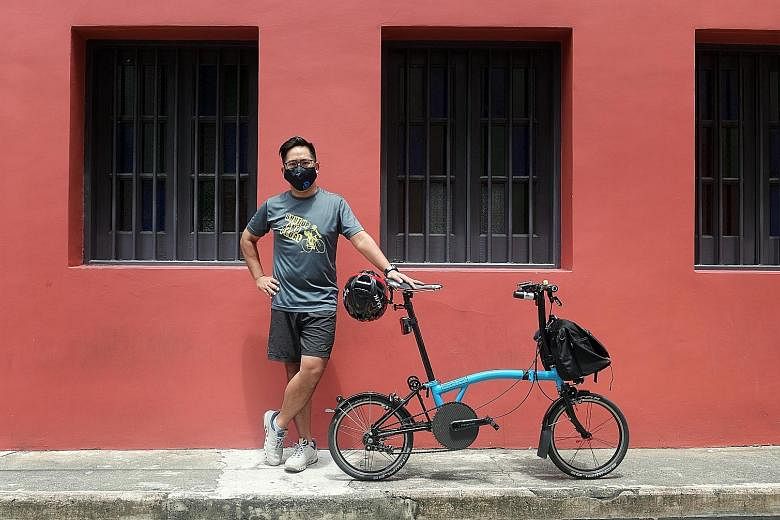The Covid-19 outbreak has made cycling more popular - not only as a leisure activity, but also as a mode of transport for those who wish to avoid buses and trains.
So much so that bicycle shops are running out of stock, and prices of popular brands have shot up.
Second-hand Brompton bicycles, for instance, are advertised for as much as $5,000 to $8,000 apiece because new ones - which cost around $2,500 - are in short supply.
And parallel importers are selling Dahon bikes for as much as 40 per cent more than what authorised agents were selling them for when they had stock.
Mr William Loo, 69, who imports KHS bicycles, said sales had grown by 30 per cent this year.
"Because of Covid-19, people are exercising a lot more. If you go on the road or the park connectors, you see a lot more cyclists," he said. "I have never sold so many bicycles before. For example, Mustafa (Centre), which used to take one or two bikes from me a week, now orders 14 a week."
Mr Paul Fam, 55, who owns a bicycle shop in Paya Lebar, said the clampdown on the use of personal mobility devices (PMDs) since last year had also contributed to the surge in bike sales.
He noted, though, that most PMD users have moved to e-bikes rather than conventional ones.
The growing popularity of bicycles has spawned several new players, Mr Fam said.
"Even durian sellers and phone-cover sellers are now selling bicycles," he added. "And some people are selling from their HDB flats."
BofA Securities analyst Rafe Jadrosich, who covers the bicycle industry, among other sectors, said there has been "a significant surge in retail sales of bicycles globally since the outbreak of Covid-19".
"Consumers are shifting spending away from traditional leisure activities towards what we call solitary leisure activities... and cycling would be one."
He cited bike stores in the United States, where sales had more than doubled in April and May; and "as soon as the lockdowns were lifted" in Europe, "long lines formed outside bicycle stores". A similar surge has been observed in Asia, he added.
Mr Jadrosich said the viability of cycling as a means of commuting depends largely on available infrastructure - and not so much on weather, which is often cited as one reason why Singaporeans have shied away from pedalling to work.
"In Europe, where the use of cycling for commuting is much higher than anywhere else in the world, it's been supported by really strong infrastructure investments," he said. "And it gets cold in the winter, for example, but you still see the mix of commuting can be very high."
Bukit Panjang resident Bernard Hii is one of the many Singaporeans who are now using the bicycle, not only for better health, but also as a mode of transport.
Mr Hii, 30, a warehouse supervisor, began cycling to his workplace in Joo Koon - about 17km from his home - before the circuit breaker period. "I want to avoid the crowd because of Covid-19," he said. "And I used to cycle in my university days in Malaysia six years ago."
Regional sales manager Carl Sahetapy, 41, started cycling to work occasionally in January. The Hougang resident works in Orchard Road, and the journey is 12km by road and 15km by park connectors.
"I did it initially to get fitter," he said. "Then in March, I did it to avoid the crowds on trains and buses."
Ang Mo Kio resident Xavier Lum, 38, also said he started cycling to work to "minimise contact with crowds" as well as to lose weight. The biotech engineer currently pedals to Serangoon MRT station on a foldable bike, and continues the rest of the way to Outram by train.
But he said he might cycle all the way once he gets fitter.




